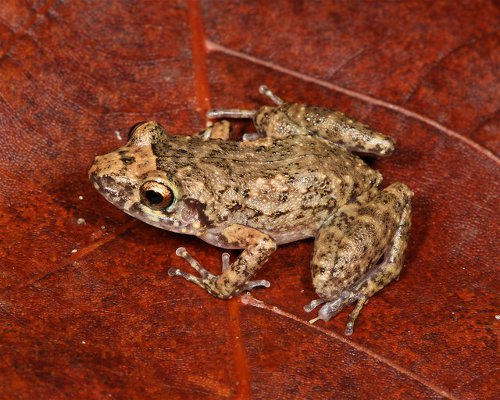
by Rick O'Connor | Apr 15, 2022
EDRR Invasive Species
Greenhouse Treefrog (Eleutherodactylus planirostris)

Greenhouse Treefrog
Photo: U.S. Geological Survey
Define Invasive Species: must have ALL of the following –
- Is non-native to the area, in our case northwest Florida
- Introduced by humans, whether intentional or accidental
- Causing either an environmental or economic problem, possibly both
Define EDRR Species: Early Detection Rapid Response. These are species that are either –
- Not currently in the area, in our case the Six Rivers CISMA, but a potential threat
- In the area but in small numbers and could be eradicated
Native Range:
Greenhouse treefrog is native to Cuba, the Cayman Islands, and the Bahamas.
Introduction:
The Greenhouse treefrog may have been accidentally introduced on shipments of tropical plants from the Caribbean. Another study suggest it may have drifted across from Cuba on debris. The earliest record is from 1863 in the Florida Keys.
EDDMapS currently list 924 records of the Greenhouse treefrog. EDDMapS records include 22 counties in Florida and 2 in Georgia. However, the USGS reports records from 49 geographic locations in Florida, 8 in Louisiana, 6 in Hawaii and Alabama, 5 in Georgia, 2 in Mississippi and 1 each in Guam, Missouri, Oklahoma, and Texas.
EDDMapS records within Six Rivers CISMA include Escambia and Okaloosa counties. The USGS records include records in Okaloosa, Santa Rosa, and Escambia counties.
Description:
This is a small frog reaching lengths of only 1.25”. Reddish brown to bronze in color with dark blotches over the body. There may be a dark triangle or chevron pattern between the red eyes. The toes are long and thin and tipped with tiny toe pads and lack webbing.
Issues and Impacts:
The impact of this non-native is still unclear. The species has been a resident in Florida for over 100 years with no noticeable impacts. It has been found co-habitating with some native species. There is some concern in Hawaii and Guam, but local impacts seem to be minimal.
Management:
With little or no negative impact, management recommendations are not provided, and maybe not be needed. If you are having a problem with this species, contact your local county extension office for advice.
References
Johnson, S.A. 2020. Florida’s Frogs and Toads. The Greenhouse Treefrog (Eleutherodactylus planirostris). Johnson Lab, University of Florida Department of Wildlife Ecology and Conservation. https://ufwildlife.ifas.ufl.edu/frogs/greenhousefrog.shtml.
The Greenhouse Treefrog (Eleutherodactylus planirostris). University of Florida Extension. https://wec.ifas.ufl.edu/extension/wildlife_info/frogstoads/eleutherodactylus_planirostris_planirostris.php.
Partymiller, L. The Greenhouse Treefrog (Eleutherodactylus planirostris). Savannah River Ecology Laboratory. University of Georgia. https://srelherp.uga.edu/anurans/elepla.htm.
Somma, L.A., 2022, Eleutherodactylus planirostris (Cope, 1862): U.S. Geological Survey, Nonindigenous Aquatic Species Database, Gainesville, FL, https://nas.er.usgs.gov/queries/FactSheet.aspx?speciesID=61, Revision Date: 5/31/2019, Access Date: 4/11/2022. https://nas.er.usgs.gov/queries/FactSheet.aspx?speciesID=61.
Early Detection and Distribution Mapping System (EDDMapS)
https://www.eddmaps.org/
Six Rivers CISMA
https://www.floridainvasives.org/sixrivers/
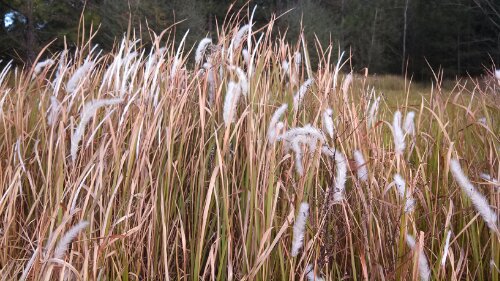
by Jennifer Bearden | Mar 18, 2022
Invasive species are defined as introduced plants and animals that cause harm to the environment, the economy, and/or human health. They often displace native species further harming the ecosystem. Many times, invasive species are introduced by humans either intentionally or unintentionally. This means WE can do some things to combat the spread of invasive species.
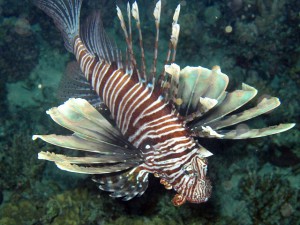
The Invasive Lionfish
In the case of intentional introductions, we typically see either plants or animals moved from native lands to our area. Most often, the mover does not know the species is dangerous to our area. Other times, they know the species is invasive, but they introduce them anyway. Exotic pets are one of the ways invasive species are introduced. The Burmese python is an example of this as well as the lionfish. These pets were released by owners who grew tired of caring for their unique needs. So, one thing we can do is encourage people to research exotic pets prior to owning them. Also, encourage people to take advantage of Florida Fish and Wildlife Conservation Commission’s exotic pet amnesty program. For plants, people should not bring any plant materials into Florida without going through the proper regulatory process.
Sometimes, introductions of invasive species are accidental. Invasive species can hitch a ride on clothing, animal fur, vehicles, and equipment. Cogongrass and Old World climbing fern are examples of plants that were moved around on vehicles and equipment. Also, invasive species can stow away in packing materials and find their way to Florida. Florida has an exceptional process to intercept invasive species, but we do see them slip in occasionally. Be very vigilant when shipping items either into or out of Florida. Clean equipment and vehicles when working in areas where invasive species are found.
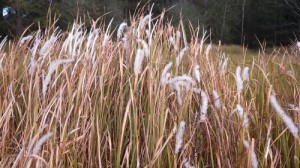
Cogongrass flowering
Florida’s climate and ports of entry allow new species to get here and survive. It is difficult and expensive to eradicate an invasive species once it becomes established. Our best defense is to do our part in stopping the spread of invasive species. For more information on invasive species, you can contact your local extension agent or go to the UF IFAS Invasive Species Program.
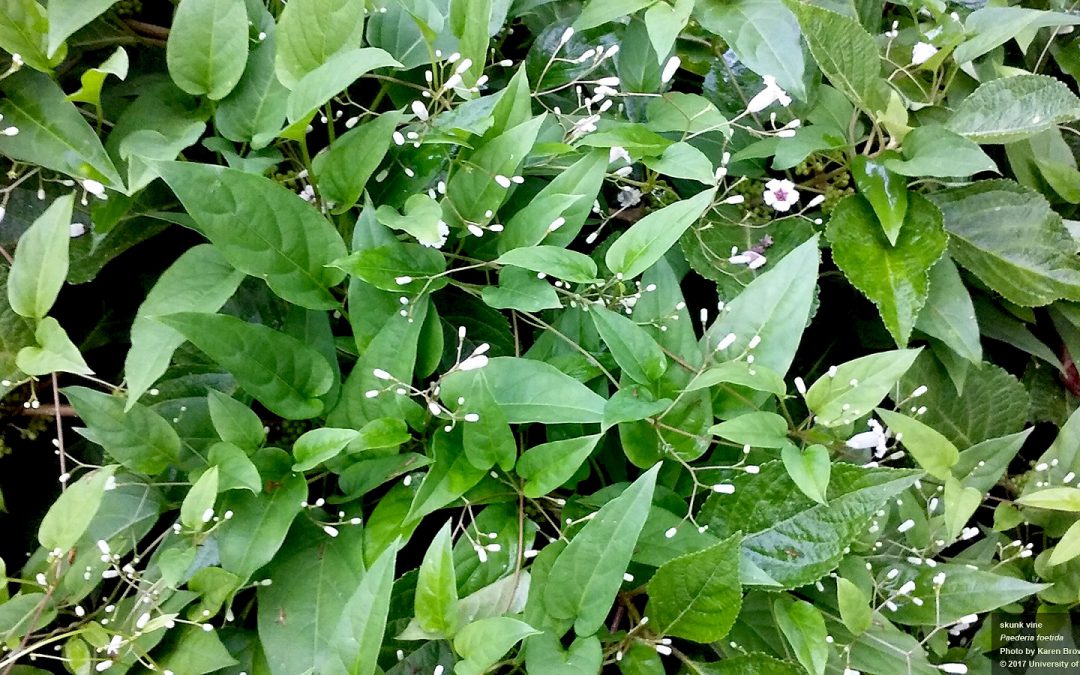
by Rick O'Connor | Mar 18, 2022
EDRR Invasive Species
Skunk Vine (Paederia foetida)

Skunk Vine
Photo: University of Florida
Define Invasive Species: must have ALL of the following –
- Is non-native to the area, in our case northwest Florida
- Introduced by humans, whether intentional or accidental
- Causing either an environmental or economic problem, possibly both
Define EDRR Species: Early Detection Rapid Response. These are species that are either –
- Not currently in the area, in our case the Six Rivers CISMA, but a potential threat
- In the area but in small numbers and could be eradicated
Native Range:
Eastern and southern Asia.
Introduction:
Around 1897 Skunk vine was introduced into Hernando County Florida as a possible fiber crop. It escaped cultivation and began to spread across central and north Florida.
EDDMapS currently list 1,252 records of skunk vine in the United States. Most are in central Florida but there are records in south and north Florida, as well as Louisiana, Texas, Georgia, South and North Carolina.
There 17 records in the Florida panhandle and 1 within the Six Rivers CISMA, that being in Santa Rosa County in the Blackwater State Forest.
Description:
This is a woody vine that can grow up to 30 feet. The vines are known to climb into the trees or grow along the ground. When crushed, the plant emits a foul odor, hence its name, and can be used to positively identify it. The leaves vary in shape but usually are heart shaped at the base, pointed at the tips, and have smooth margins. The flowers are small, light grayish pink in color, with red centers. The fruits are small and shiny brown. It can spread vegetatively or by seed.
Issues and Impacts:
This plant can survive in a variety of habitats including dense hardwood forest, pine forest, sandhills, floodplain forest, and marshes. Like kudzu and other vines, this plant will overgrow native plants on the ground and over trees. It can fill a tree canopy causing the collapse of it. It is a Category I invasive plant and a state noxious weed.
Management:
Care must be taken when trying to remove this plant. Stem fragments and seeds are easily lost when moving and can generate new plants. Extensive flooding may kill the plant, but it is known to live submerged for up to 190 days.
Skunk vine tends to invade open-disturbed areas within the forest. Mowing and tilling can help but are impractical in many cases. Studies on biological controlling insects are ongoing and show much promise.
Chemical control seems to be the most effective method at the moment, but single applications rarely complete the job. Triclopyr, with a surfactant, as a foliar spray has been effective. Glyphosate has also been effective. Care must be taken not to overspray onto other plants. Vines growing in trees should be pulled down and then sprayed to allow the herbicide to be pulled into the root system. The best time of year to do this is spring and summer.
Please report any sighting to www.EDDMapS.org. There are biologists who verify the photograph you send. It is important that we keep track of this EDRR species.
For more information on this EDRR species, contact your local extension office.
References
Paederia foetida. Skunk Vine. University of Florida Center for Aquatic and Invasive Plants. https://plants.ifas.ufl.edu/plant-directory/paederia-foetida/.
Early Detection and Distribution Mapping System (EDDMapS)
https://www.eddmaps.org/
Six Rivers CISMA
https://www.floridainvasives.org/sixrivers/
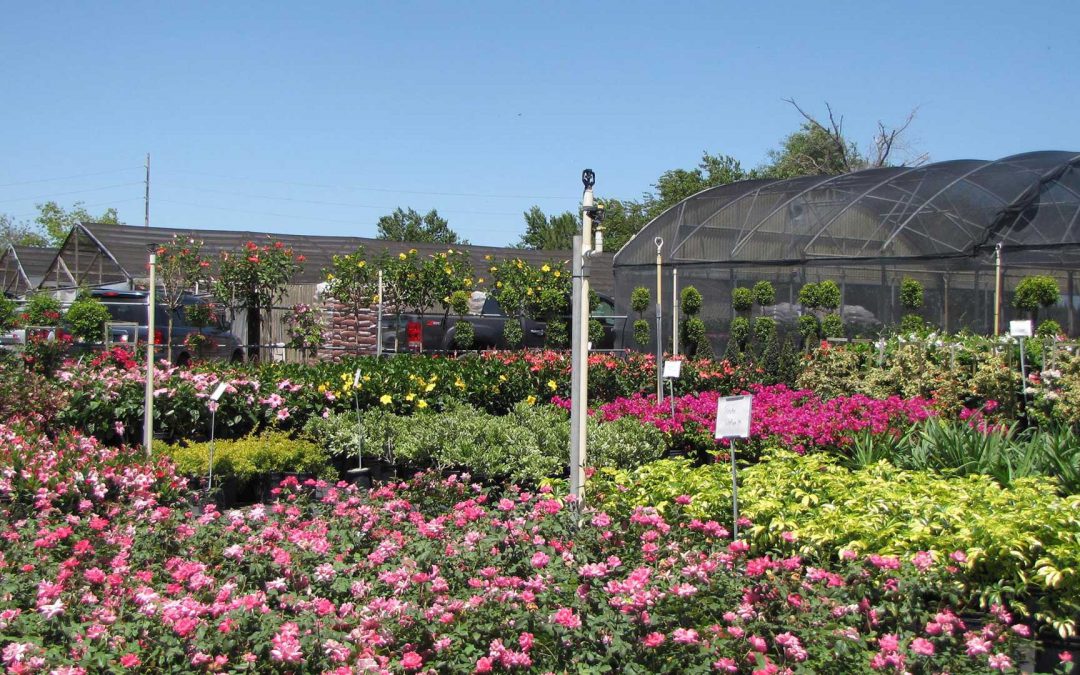
by Rick O'Connor | Mar 18, 2022
It is that time of year. The time of year when many head to their favorite nurseries to do their spring landscaping and gardening. Many of the plants sold at these locations are actually grown in more southern climates, where there are numerous invasive species of all sorts. Many of these invasive species have not made their way to the Florida panhandle but can hitchhiker on these plants when they are shipped up this way. Care should be taken when purchasing to make sure you are not bringing anything home other than the plant you want.
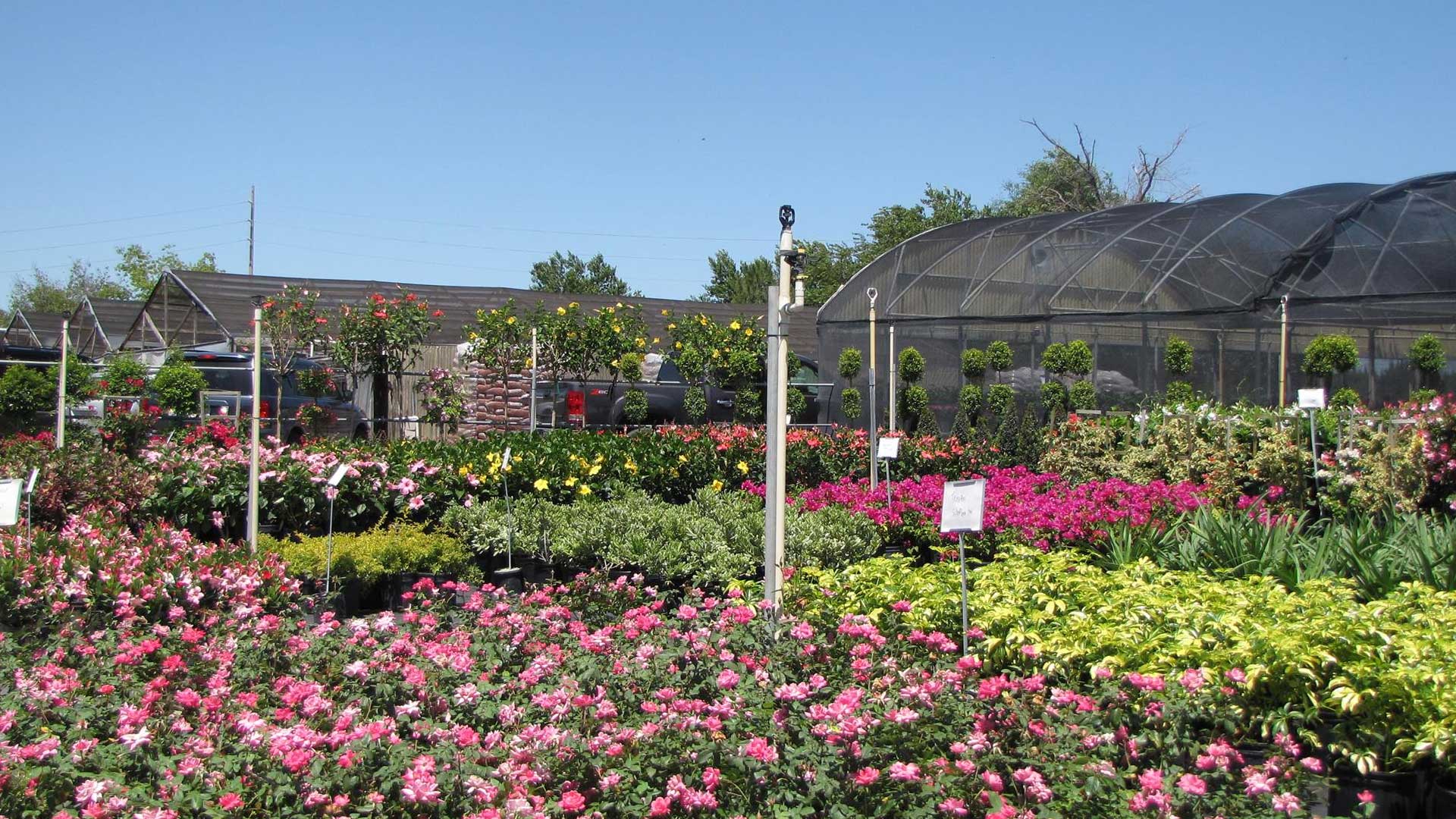
Nurseries provide native and nonnative plants.
The best management tool for invasive species is prevention. Across the country, particularly out west, there are survey stations at public lakes and reservoirs where state officials inspect boats and trailers when they arrive and when they leave the lake. There are hiking boot brushes at the entrance and exists to trails and active machine cleaning efforts after working in the field. Here in Florida, we do not pay as close attention to this. Machinery, boats, and plants are moved with little or no inspection. On any shipped plant could be an insect, slug, lizard, or frog that could eventually cause trouble for us. We are sure this is how the brown anole was introduced and we now getting reports of Cuban treefrogs in the panhandle.
Potential threats as EDRR species to our area include channeled apple snails, Cuban treefrogs, and greenhouse treefrog. With pond plants we need to be on the watch for several including Eurasian milfoil, water hyacinth, giant salvinia, and hydrilla. We also want to avoid purchasing and planting beach vitex, callery pear, coral ardisia, guinea grass, natalgrass, skunk vine, and swamp morning glory since they are all considered potential threats to the western panhandle.
If you have a question as whether a specific plant is invasive or not, you can visit the University of Florida’s Center for Aquatic and Invasive Plant website – https://plants.ifas.ufl.edu/.
The University of Florida IFAS Assessment website – https://assessment.ifas.ufl.edu/.
Or contact your county extension office.
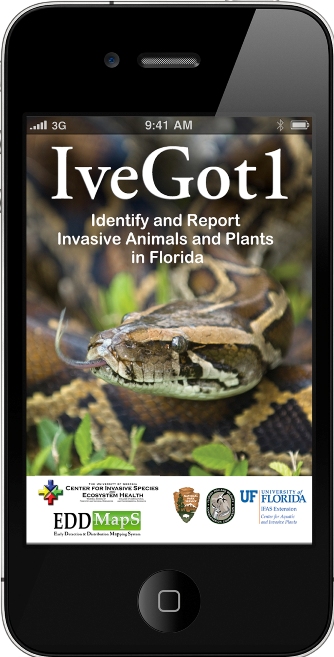
by Rick O'Connor | Mar 4, 2022
During this week we have read about what an invasive species is, how they got here, which ones have been here awhile, which are new potential threats, and why we should even care about this. All important things to know when you are trying to understand invasive species. But what can you do about it? Is there anything that can be done from your side?
Yes… there is.
The first step in helping to manage invasive species is to learn which plants and animals in your landscape are invasive. Many of the animals are easy, but the plants not so much. I have already heard from a few of you about Mimosa – like me, we had no idea it was on the list. But we should know which plants are and are not. How do you learn this?

Unfortunately, Six Rivers CISMA’s new website is not live yet. It should be by April 1, 2022, and when it is there will be information for you there. Another way is to check EDDMapS (www.EDDMapS.org). You can search the distribution map at the tool bar, type in the name of the species you have a question about and see if there are records. If it is, this does not mean it is invasive in Florida, just that it is invasive somewhere, but it is a start. If it is a plant (and most have questions about plants more than animals) you can search the University of Florida IFAS Assessment (https://assessment.ifas.ufl.edu/). This database will give you the status of the plant in Florida. However, you will need to know the scientific name of the plant. You can find this by googling the common name and finding it that way. Of course, you can always contact your county extension office.
Here is one for the SCUBA divers out there. I met with a couple of experts a year ago or so to discuss a list of 20 potential nonnative fish threats to the Florida Keys. We discussed which of these could become threats in the northern Gulf, could tolerate our climate. It was decided that we should tell divers if they see any fish that looks out of place, never been here before sort of thing, get a photo and contact us at the extension office. We will go from there.
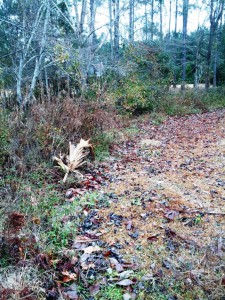
Survey your yard
The second step is to conduct a survey of your yard or business. You probably know your yard already, but most have crews handle the landscaping for their businesses. You can conduct the search for plants but let your landscaping crew know your interest in any unusual animals they may see. You can also participate in community surveys with the county extension office. As COVID restrictions begin to lift, we will be conducting more of these in public areas in the coming months. Check our website calendar.
Be aware of what you are buying and bringing home this spring during gardening time. Not just the plant that you are buying, but who might be hitchhiking on it. Many of the ornamental plants people purchase are grown in large nurseries in central and south Florida. We believe this is how the Brown Anole, and now, the Cuban Treefrog are getting here. Slugs, lizards, frogs, all sorts of creatures can hitchhike on your plants. Just give it a good look over and if you think you have a potential invasive, call us.
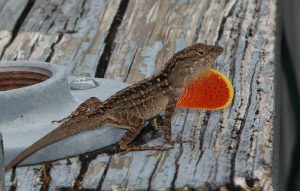
Cuban Anole. Photo credit: Dr. Steve A. Johnson, University of Florida
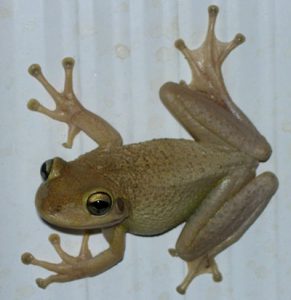
Photo by: Dr. Steve Johnson
The third step is to report them. As you saw in the numbers, and I did not post the Dirty Dozen numbers, but all of them are under reported. Having the public report these to EDDMapS gives managers a better idea of the extent of the problem. Note: You are not allowed to report an invasive species on private property without their permission, please get this first.
How do you report to EDDMapS?
There are two options.
One, go to their website (www.EDDMapS.org). You will see “report a sighting” on their tool bar. Report here. It will ask for a password, so you will need to set up an account. It will ask for area covered; estimating is fine. It will ask for Latitude and Longitude, most phones can give you this. Note: input longitude as a negative number or it will post the location in the eastern hemisphere. It will want a photograph so that it can be verified. This is important. Many are nervous reporting because they are not sure they have identified it correctly. No worries. All records sent in are verified before they are posted. A good photograph will allow the verifiers to do this. Send the record, if they believe it is incorrect, they will not post it.
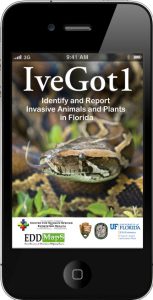
The second option is to use the IveGotOne app. This app handles a lot of the needs for EDDMaps. You see the plant, aim the phone, take the picture, and tell it the area covered, send. Everything else is taken care of. REMEMBER, you must get permission to do this on private property. You can get this app from the EDDMapS website or your favorite app store.
The fourth step is to remove it. This is the hard part.
Hard in the sense that most can remove small weeds and vines and are happy to do so. It is harder when there is a large infestation or if it is an animal – it is not easy to euthanize an animal, for anyone. How do we handle those harder ones?
With plants, contact us at the extension office – or visit the Six Rivers CISMA website when it is live. There has been a lot of research conducted on different methods of removal that will be effective and little impact on the environment. Many do not want to use herbicides, and we get that, but in some cases that may be the only option. So, which herbicides are the safest to use and in what concentrations? Again, give us a call. Interestingly, I recently heard from a local contractor who removes aquatic plants from ponds. He said he could do the same for invasive species. We hope to find a lot of such contractors who might be able to help with large problems that you cannot do yourself. Stay tuned.
With animals it is even harder. Even though there are humane ways to do this, most people cannot just put animals to sleep. Most county animal control units do not deal with invasive species. Instead, you would call the Florida Fish and Wildlife Conservation Commission. They have a number you can call Monday – Friday during normal business hours – (888) 483-4681. If it is after hours, or on the weekend, call (888) 404-FWCC (3922). Either FWC, or a licensed contractor, will come to deal with it. I will let you know they are probably not coming for the Brown Anoles so many have in their yards at the moment. There are just too many of them. Note: it is illegal to transport an invasive species in Florida. If you have a problem please call, do not bring it in.
If you feel you could euthanize an invasive animal first make sure on the identification. Get a good photo and send to your county extension office. If it is, your extension office can give you information on how to humanely euthanize the animal.
Note that there is nothing illegal about having invasive species in your yard. You will not be cited for having such. It is just many do want to remove them.
We hope you have learned a lot this week about invasive species. If you have, email me at roc1@ufl.edu and let me know. And if you decide to report or remove a species, I would like to know this as well.
Hope all is well with everyone.
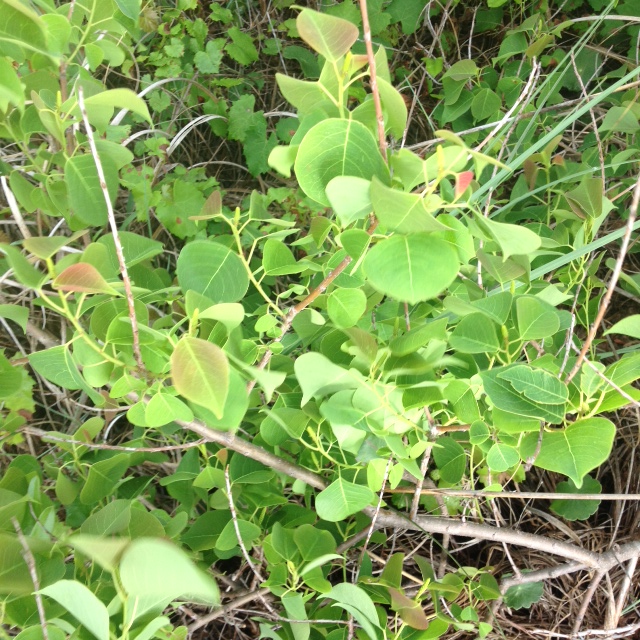
by Rick O'Connor | Mar 3, 2022
The name lets you know that these are probably not good. What we call the Dirty Dozen are those invasive species who are in the high part of the invasive species curve. The section to the right that is red. They are widespread and abundant. They are here and not going anywhere. We are not going to get rid of them. Which brings us back to our first article, why bother then?
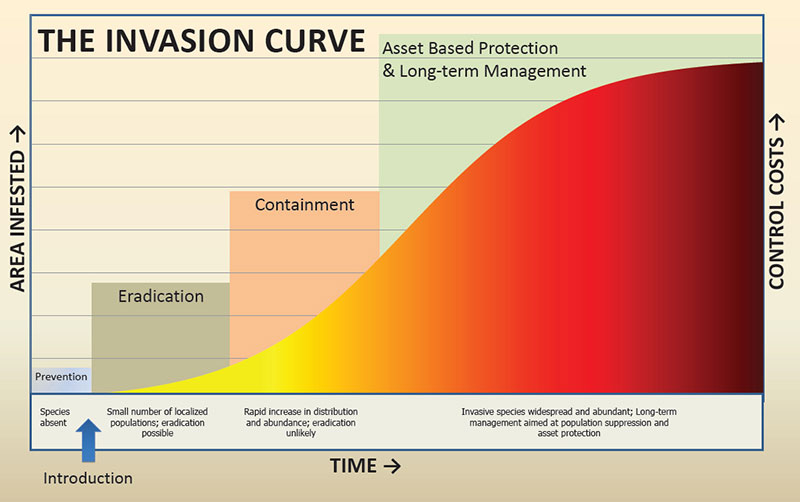
Here is analogy that many of you may relate to. There is a native green vine with thorns that grows in the Florida panhandle known as green briar (Smilax). It can be a horrible plant. Vines growing everywhere, thorns tearing at your skin and cutting your clothes. I have seen it growing next to my house literally overtake a large pine tree. It grows over shrubbery, landscape lattice, just a real pain. We do not like it. I cannot get rid of it, it is here to stay, so – why don’t I just walk away and let it grow?
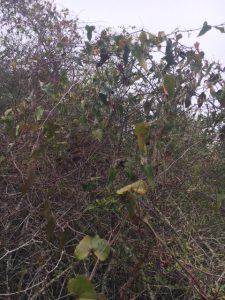
Smilax, green briar, is a nuisance native plant.
Well, we know what will happen. It will overtake our landscape a create a ball of briars and thorns. I ran into such a place while hiking on Pensacola Beach recently. It was absolute hell trying to get through and I will always walk around such a mess again. Yes… we will manage it in our yard. We will not let it go. And so goes the Dirty Dozen. We should not ignore.
The Dirty Dozen are the top 12 problematic established invasive species within the Six Rivers CISMA selected by its members. A lot of species could be on the list, but the members felt they were having the toughest time with these twelve. Let’s meet them… (these are in no particular order).
- Callery (Bradford) Pear. Yes… this was listed as an EDRR yesterday. I am not sure where this fits. It is either a large EDRR issue, or a small Dirty Dozen (D-12) problem. There are 174 records of this plant in the Florida panhandle and most records come from the Blackwater Forest area. I think this is because they have an aggressive invasive species management program and do an excellent job reporting. It is probably quite common everywhere.
- Chinese Privet. Interestingly, in my mind, this is a north Florida problem. During my travels in south Florida, I never see it, but along I-10 you see it everywhere. It is sort of our Brazilian pepper (a major south Florida problem). And it is everywhere. There are very few places, urban or natural areas, where I have not seen it. Many may not even know what it is.
- Chinese Tallow. This is the famous popcorn tree and yes, its everywhere. One thing I have noticed about this plant is that it seems to move into disturbed areas. Along roadsides and trails, housing developments and agricultural lands. I have seen one grove take over a retention pond, this plant does not seem to have a problem with wetland habitats. This is also the one that beekeepers say make great honey. It is toxic to livestock and wildlife.
- Cogongrass. This invasive plant appears to have entered the U.S. on pallets entering the Port of Mobile. It quickly spread from there across south Alabama, Mississippi, and covers much of Florida. It is easily transported by mowing vehicles that try and mow it down. Many land managers have now learned this and have adopted better practices. It has leaves with serrated edges and silica. Livestock and wildlife do not eat it. It is considered a federal noxious weed and one of the worst invasive species we deal with by many land managers and biologists.
- Feral Hogs. Wild pigs, or feral hogs, are a problem. They destroy large tracks of habitats digging for food. They are very resilient to management efforts and are a real problem for private and public landowners.
- Japanese Climbing Fern. This is the north Florida cousin to south Florida’s Old World Climbing Fern. Both are bad news completely overtaking the landscape as green briar does. Managing it is difficult and it spreads easily by spores. Sometimes managing it can enhance its dispersal.
- Japanese Honeysuckle. My experience with this plant is that it is not as abundant as Japanese Climbing Fern, but where it is found it is aggressive and most be managed.
- Kudzu. Enough said… This could be the poster child (and often is) for invasive species problems. It is a much larger problem in Alabama and Georgia, but north Florida certainly has its problems with it. Like so many of these D-12, it is difficult to manage.
- Mimosa. I grew up with this tree in our landscape and had no idea it was (a) nonnative and (b) an invasive plant. It falls into that category of invasive species that is pretty and people enjoy having it in their landscape. The problem associated with it is that it out competes native species. There is the threat of decrease biodiversity and so, it is listed as invasive. For those trying to manage it in our area, they consider it one of the D-12.
- Red Fire Ant. No one likes this creature. Well, maybe Dr. E.O. Wilson did, but everyone else does not like this animal. We are all too familiar with how aggressive this animal can be and how painful their bites are. They can be found in a variety of landscapes and spread quickly. Their impacts are huge and, as many of you probably know, their management difficult.
- Red Lionfish. This is one that most know about now. This has been reported as being one of the worst invasions of all invasive species ever. Producing an average of 30,000 fertilized eggs/female/week and the fact that they can live to depths of 1000 feet makes management very difficult. However, there has been some success in depths less than 200 feet, and, like all D-12 species, you just have to keep at it. Don’t let the “green briar” overtake.
- Those who know this grass know how hard it is to manage and how quickly it spreads. The team with Gulf Islands National Seashore has been battling it for awhile now. It likes to grow along the waters edge and can be submerged for a short period of time. Those who do not know it, may have it along their waterfront.
Again, these are invasive species we let get to point where management is almost a full-time job and the cost of doing so it quite high. This is why it is so important to manage the EDRR species and avoid this problem. It begins with education of the issue, which we hope you are getting.
Tomorrow is the last day of NISAW 2022, and we will finish with a discussion on what you can do to help manage this problem.

















